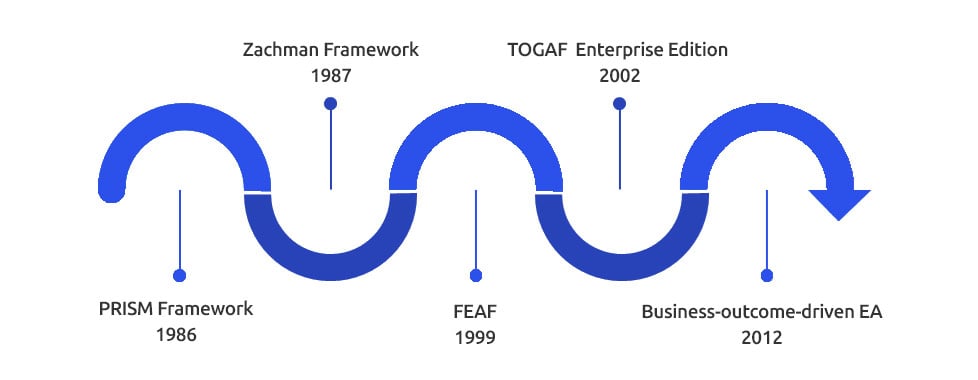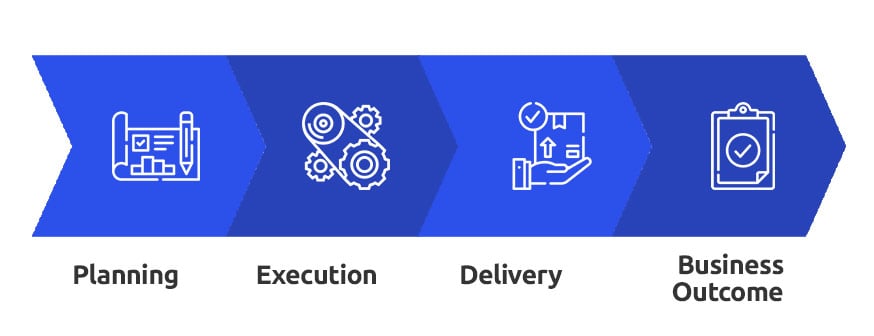Digital Transformation | 25 Aug 2021 | 12 min
What is Enterprise Architecture?

The race as they say is on! Every organization is racing towards the finish line trying different ways to be more agile, transform so that their bottom line improves substantially. They are on a race to meet customer expectations to provide seamless services and enriched products. But it is a relay, not a single sport, you will need to rely heavily on your people, improve your processes, and hand over the baton to technology in the final lap to blitz through to the finish line. That is what enterprise architecture is all about.
Enterprise architecture (EA) is a holistic approach relying on people, processes, and technology to identify and analyze how to best execute a strategic goal or business vision. Even if one of these is left unattended or performs below expectations then everything can comes crashing down – your architectural shortfalls exposed.
Enterprise architecture frameworks (EAF) is a set of principles and practices that can be used to create enterprise architecture. The framework also provides organizations with a set of tools to innovate, plan, execute, and take strategic decisions by analyzing their business, technology, information or data, and solution or application architecture.
This means that an EAF will give you a panoramic view of your IT, use technology to help you store data, derive insights, and provide enhanced customer satisfaction. There are many enterprise architecture frameworks that can help you execute strategy in an agile, efficient, and secure manner.
Here’s a short overview of types of frameworks:

a. PRISM framework: It started with Partnership for Research in Information Systems Management (PRISM) framework in 1986, where four aspects of information systems came to the fore. Four types of architectural processes, it showed, could be applied to the infrastructure, application software, data, and the organization.
b. Zachman Framework: The Zachman framework reared its head in 1987 and since then is considered more as a template for Enterprise Architecture. It divides the information architecture in an enterprise into structural components. This means it takes a step beyond IT, which I think was like a Marie Kondo of its times-categorizing to organize a variety of documents and materials in places where they ought to be. It involved playing with six perspectives (owner, designer, builder, implementor, operator) and W5H (What i.e., the material; How i.e., process; Where i.e., geometry; Who i.e., operating instructions; When i.e., timing; lastly, Why i.e., engineering design objective) to help you make great business decisions.
a. Federal Enterprise Architecture Frameworks (FEAF): This originally started in the 1999 to make sharing of common processes and information between federal agencies and the government easier. It was divided into four types, viz. business architecture (W5H), data architecture (information), application architecture (apps processing data), and technology architecture (technology or hardware). There is also an improved version of FEAF called FEA which launched in 2006 that combines the best of the Zachman framework and the TOGAF to help companies build stronger futures.
b. The Open Group Architecture Framework (TOGAF): This is probably the most famous and widely used framework for enterprise architecture and first appeared in 1995, but the enterprise edition came into being in 2002. TOGAF can help organizations create an independent architecture using a common set of vocabulary, standards and compliance methods, tools and software, and best practices. This framework is based on the Technical Architecture Framework for Information Management (TAFIM) and Integrated Architecture Framework (IAF). It acts as a sort of decision making and IT resource guide for organizations. It aims to integrate all layers of an enterprise be it technology, applications, IT infrastructure, business strategy, and information to provide quantifiable solutions.
There are probably tens of thousands more frameworks out there which I haven’t listed, some of them developed by consortiums like ISO 19439, some are defense industry frameworks like DoDAF/ MODAF, while a few others are frameworks crafted for government agencies like TEAF, some like TRAK can also be classified as open-source frameworks, and finally frameworks like Zachman Framework, IAF, ASSIMPLER are all proprietary ones.
Frankly speaking times have changed, although I have listed out the frameworks that will guide you when you leverage enterprise architecture frameworks to achieve your business goals using technology and strategy across the enterprise, I have that nagging feeling of not showing you the flip side of things.
For starters, yes, it was planned way of doing things, but for some reason it just looked too planned and inflexible for practical use. It is possible this copious amount of documentation that you do might fill up the British library (apparently that is one of the largest libraries in the world), but would you consider it useful if it poorly documented or gets outdated before you could fill the next entry?
Then why do I say you need to invest in Enterprise Architecture? That is because despite all this, organizations have the goal of digital transformation for their business-balance is important for innovation.
This is where something changed in 2012, organizations started shifting from the framework mindset to something called the business-outcome-driven-EA, where the focus is not just the project but also the product.
The frameworks may be large and complex, so what enterprise architects need to understand is that EA is an iterative process where you can build subsets of the frameworks you choose, that way you can have focus on specific business outcomes.
Moving from a process driven EA (what needs to be done) towards business-outcome-driven EA (how to enable change) starts with planning. Each enterprise architect can collaborate with the leadership, product owners and chalk out a direction for the business. Then see it through by executing it throughout the delivery lifecycle which leads you ultimately to fulfilling your business goal.

In conclusion, enterprise architecture requires some form of inventiveness at your end. And the best form of creativity often comes from things around you. EA frameworks like I already said restructure all the information that you get from your technology, data, solution, and business. So, if you take these frameworks and customize it to suit your business outcomes, you are painting a larger picture for your organization in an agile manner with endless possibilities. It acts like a tailor-made solution for the future state of your enterprise.
Go ahead, get creative with your enterprise. If you have any questions, you can write to us, or even read more about how we at Nitor have reformed business models with enterprise architecture.

we'll keep you in the loop with everything that's trending in the tech world.
